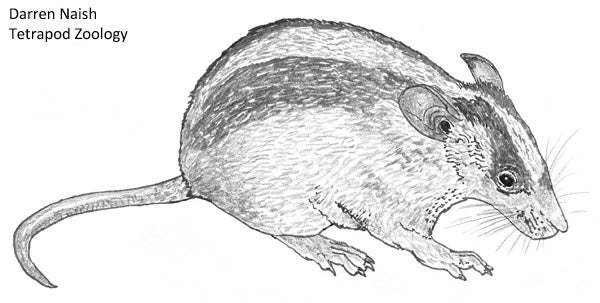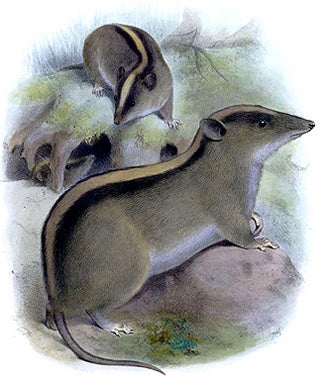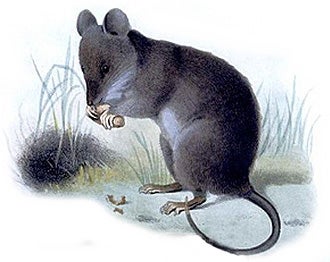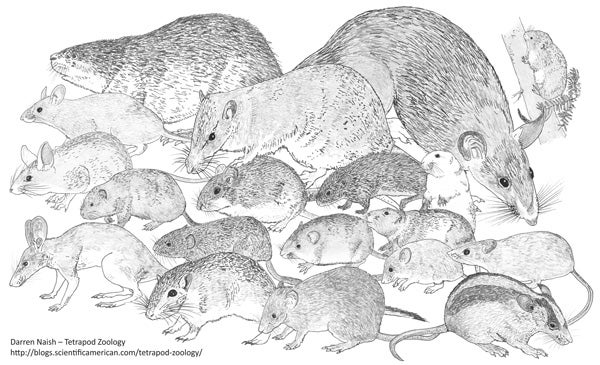This article was published in Scientific American’s former blog network and reflects the views of the author, not necessarily those of Scientific American
I’ve mentioned on occasion how vast, sprawling and complex the mouse family (Muridae) is. You’ll know this already if you know anything about mammals, or rodents specifically. As usual with grand radiations of this sort, I don’t feel as if I’ve done any more than scratch the surface when it comes to discussing the diversity of this group. But, it’s hard, given other commitments and the time it takes to get some of this stuff together (especially when you like using images). Anyway… let’s look at some obscure mice.

Luzon striped shrew-rat Chrotomys whiteheadi, a portrait drawn from assorted photographs. Credit: Darren Naish
The Luzon striped mice, shreats, shrew rats/shrew-rats or earth rats (Chrotomys) are a small group of Philippine endemics. They have pointed snouts, a short tail and a somewhat shrew-like demeanour, and indeed are semi-fossorial, insectivorous, shrew-mimicking rodents. They’re mid-sized, head and body length being 15-17 cm. It’s thought that they took to a shrew-like role in view of the local absence of shrews and that they’re part of the ‘Old Endemic’ group of Philippine murids (Musser et al. 1985, Musser & Heaney 1992) – one of the first wave of murid migrants to arrive on the islands. Within this group, Chrotomys is unique in possessing stripes. I’ve been meaning for years to do a big review article on Philippine murids as a whole – such a fascinating bunch.
On supporting science journalism
If you're enjoying this article, consider supporting our award-winning journalism by subscribing. By purchasing a subscription you are helping to ensure the future of impactful stories about the discoveries and ideas shaping our world today.

Chrotomys whiteheadi, as illustrated by Joseph-Smit in 1883. Credit: Wikimedia Public Domain
The stocky proportions, strong limbs, long and heavily built, wide, spatulate manual claws and short tails of the Chrotomys species are typical of mice that dig and use burrows. The fur is typically dense and soft. The rostrum is rather slender and pointed when seen from above, the teeth are slender and the upper incisors are strongly prognathous. They’re primarily associated with montane and mossy forests (C. mindorensis is the only lowland species), are apparently diurnal, and are partly dependent on earthworms. That last factor may explain why at least some species (C. mindorensis and C. whiteheadi) appear to be quite tolerant of habitat disturbance, since worms may be especially abundant in places that have been disturbed (Rickart et al. 2005). However, it’s suspected that the others are at risk from habitat loss and degradation.

At left: skull of holotype of C. sibuyanensis. At right: the complete holotype in (A) dorsal, (B) ventral and (C) left lateral views. Credit: Rickart et al. 2005
Five Chrotomys species are presently recognised, two of which were named since 1990: the Isarog striped shreat C. gonzales, named in 1991, and the Sibuyan striped shrew rat C. sibuyanensis, named in 2005. The C. sibuyanensis holotype was actually collected in 1992, another reminder that ‘discovery date’ and ‘description date’ are often far from being the same thing.

Silver earth rat C. silaceus, as illustrated by Joseph Smit in 1883. Credit: Wikimedia Public Domain
The Silver earth rat C. silaceus has been regarded by some authors as distinct enough to warrant its own genus – Celaenomys – since it’s smaller than the others, usually (but not always) lacks stripes, has shorter, denser, greyer fur, and has a narrower skull and more reduced molar count. Recent molecular and morphological work have shown that it’s not substantially different from the others and hence they are best all regarded as part of the same genus (Rickart et al. 2005).

A selection of mice, voles and their muroid kin - one of many mammal montages compiled for my in-prep textbook project, on which see more here. If you like rodents, there's a Tet Zoo t-shirt (and other merchandise) available here. Credit: Darren Naish
And that’ll do for a quick summary. I’ll be covering more obscure murids in future. For previous Tet Zoo articles on murids and other rodents, see…
Refs - -
Musser, G. G., Heaney, L. R. & Rabor, D. S. 1985. Philippine rats: a new species of Crateromys from Dinagat Island. American Museum Novitates 2821, 1-25.